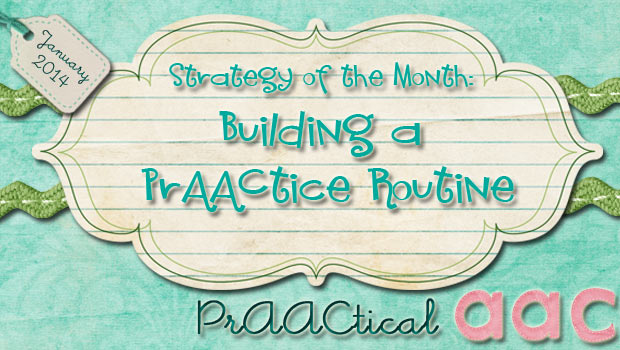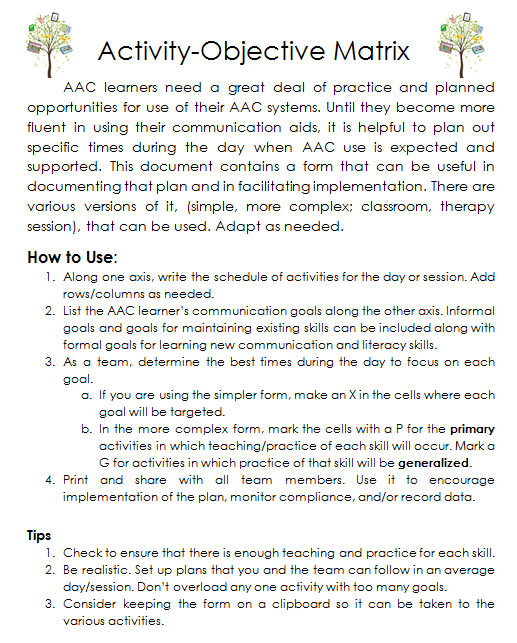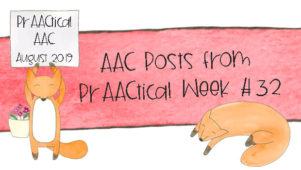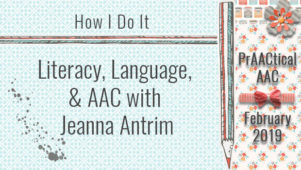Strategy of the Month: Building a PrAACtice Routine

There’s an old joke about a tourist wandering around New York City in search of the famed musical venue that has been home to countless performances of classical music. After walking in circles, he finally stops a resident to ask for directions, “How do you get to Carnegie Hall?” “Practice, practice, practice,” was the reply. And so it is with AAC. No matter what their age or disabling condition, there is one thing that every AAC learner needs: Practice. A lot of it.
It takes a lot of daily practice for people learning to use AAC in order for them to:
- Become fluent with their AAC systems
- Build their vocabularies

- Develop their syntactic skills
- Respond more quickly
- Communicate less effortfully
As we’ve said before, we tend to like things that we’re good at and things that are relatively easy for us. It time and a lot practice for some of our AAC clients to get to that point.
How can we make that happen? Most of us have a very limited amount of time with our clients who are learning AAC and often feel like we are barely scratching the surface. This month, we’ll focus on a menu of ideas that SLPs can use to create a sustainable routine in which AAC learners get the practice they need. Highly experienced AAC practitioners working in effective teams may be able to pull this off spontaneously. But most of us do better with a plan.
One of our favorite tools for prAACtical planning is a chart that cross references the learner’s goals with his/her daily activities. The idea is pretty simple: we list out the target areas (goals) and see which activities could be used to teach and practice those skills. Obviously, a team approach is needed to set this up so that everyone is comfortable with the plan. We started out using this approach in classrooms, but sometimes use a matrix like this for individual therapy sessions as well. At their request, we’ve also helped families who are interested in infusing home prAACtice set up this kind of thing.
Once established, we can use this matrix for a couple of purposes.
- As a guide: It helps ensure that a) there is enough practice for each new skill throughout the day, and b) keeps us from overloading any particular activity with a million goals to target. Better to set up a more limited plan that gets implemented with fidelity, than a more ideal one that rarely gets followed.
- As a reminder: Displaying charts like this can help remind us what we should be focusing on in a particular activity. Follow your agency’s guidelines about displaying client-specific material and de-identify, if necessary.
- As a monitoring tool: Am I actually targeting the selected skills during each activity? An administrator, mentor, or peer can use this tool during their observations of my therapy. We’ve also seen teachers use this quite effectively in their guidance and supervision of paraprofessionals.
- As a data collection tool: Print out multiple copies to use and keep on a clipboard so that you can take the data right on the form. Better yet, laminate a single copy and use a dry erase marker for the tally marks.
- As visual support: In meetings and conversations, this can help us explain how we address each goal throughout the day. This can be particularly helpful when the SLP is pushing into the classroom and/or in the role of consultant.
Everyone does better when they know what is expected of them, and the Activity Objective Matrix is one way to help convey those expectations. You can download our version in the eToolbox of by clicking on the image. 
The path to communicative competence in AAC is paved with practice. If there’s another road, we haven’t found it.
Filed under: Strategy of the Month
Tagged With: Activity Objective Matrix, documentation, download, form, planning
This post was written by Carole Zangari





1 Comment
I love this! I hope I can get my team on the same page with this! Do you have resources for organizing vocabulary and symbols on devices? I know it’s student/device specific but it’s such an intimidating task to me! I don’t know where to start. Thanks again, PrAACtical AAC!